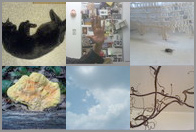The Center for Arts Management and Technology would like to wish the Technology in the Arts community a very happy holiday week! Here's to a safe and prosperous 2008!
Check out someecards.com for hilarious electronic greetings.
As the video game industry continues to grow, Hollywood studios are capitalizing on this intellectual property (IP) success through film and television adaptations. Students from Heinz College’s Master of Entertainment Industry Management program sought to better understand the current market for these adaptations. In Part II, see what film and video game executives consider to make an adaptation successful. Additionally, through a survey of gamers and non-gamers, learn what potential audiences prefer to see.
Colonialism has consistently been a force in the global purview, including the technological space. In recent years, the expansion of artificial intelligence has vastly increased corporations’ global influence. As the world’s technologies continue to advance and innovate, individuals must keep a watchful eye on the ways in which digital colonialism might repeat harmful practices from the past.
Due to the popularity and booming business of video games, Hollywood studios have capitalized on popular game titles by developing new content based off of their intellectual property (IP). This study sets out to better understand video game IP’s impact on film and television markets and what specific elements might impact an adaptation’s success.
Sustainability and AI were at the forefront this year at the American Alliance of Museums (AAM) Future of Museums Summit. What role will museums play in creating climate-friendly communities? And how can AI be used to maximize efficiency, increase accessibility, and deepen engagement? Read key conference takeaways from Xueer Ho and Dr. Brett Ashley Crawford.
An overemphasis on data-driven work within the nonprofit sector has been shown to result in cycles of disempowerment, driven by third-party data demands of funding bodies.. This compounds due to the many market orientations nonprofits need to adopt, particularly prevalent among the arts. A key to navigating these markets and funder requirements lies in identifying a specific data culture best fit for your organization and investing in resources and training in order to achieve that framework sustainably.
The Center for Arts Management and Technology would like to wish the Technology in the Arts community a very happy holiday week! Here's to a safe and prosperous 2008!
Check out someecards.com for hilarious electronic greetings.
As this is a blog, I thought it appropriate to point out that Monday was the 10-year anniversary of the term "weblog." The term was first coined on December 17, 1997, by Jorn Barger, an interesting character, to say the least. Barger is a thing of Internet lore, having spent time as a software programmer, a technology theorist and, most recently, a homeless drifter.
Here's a 2005 photo of Barger:

Eek. He may be a bit Charles Manson-esque, but he's the father of blogging, and he deserves some recognition this week.
If you want to check out Barger's own blog, Robot Wisdom, visit www.robotwisdom.com. As Barger believes a blog should be more a history of Web travels than a journal, you'll notice that he comments very little and mostly offers up links.
And if you'd like to read more about Barger, visit his entry on Wikipedia. Remember, not everything on Wikipedia is true, so take the tales of Barger's travels and trials with a grain of salt.
Powered by ScribeFire.
The folks at Misnomer Dance just sent me a link to their proposal to IdeaBlob for $10,000 that would allow them to build web-streaming for dance rehearsals, create an online theater where visitors can watch and direct performances and develop tools to display the geographic are of online audiences. Of course, the skeptic in me wants to know how you could possibly do all this for $10,000, even assuming that it will all be done low-cost, mash-up style. On the other hand, the idealist in me wants to get in on that online theater thing right now! Body mounted cameras? Sign me up! I've always wanted to know what it's like to be able to jump as high as dancers, or be lifted up and twirled around over someone's head... Maybe this would be my chance to find out!
If you'd like to vote for Misnomer to win the $10k, click here.
Well, I’m down in sunny, breezy Miami, FL, enjoying the warm weather and the Americans for the Arts NAMC. It’s been a busy two and a half days of conferencing, and I just wanted to take a minute and share a few cool things I’ve learned while here:
Well, that’s all for me. I’ve got to grab a bite, hop on a flight, and head back to wonderful, but cold, Pittsburgh, PA.
For more information about AFTA's NAMC, please visit: http://www.artsusa.org/events/2007/abc/namc/default.asp
Steve Bradley, one of our illustrious speakers at next week's conference, sends the following invitation: cell stitch an open participatory mobile media project by URBANtells

Call for cell phone based photographic and textural contributions. Create a series of photographs that best describe the place where you live, work and play. Take as many images as you like focusing on details that make the place you live perhaps unique, mundane, or like every other city in the U.S. Include one to twosentencenarratives along with your pictures and send them to: urbantells@wintermute.org
It takes anywhere up to 5 minutesfor the image to show up on the page, http://urbantells.net/cell-net/
Reload the page until the image appears within the grid.
The National Museum of African American History and Culture has built is home on the Web, years before it actual finishes construction on its physical home (scheduled to open in Washington, DC, in 2015). The site is a great example of using the Web for community building. Most interestingly, they have developed a Memory Book, which allows site visitors to contribute stories, thoughts, photographs, and any other insights they have. The NMAAHC also has posted several audio interview samples from its StoryCorps Griot, which aims to collect and present the voices, experiences and life stories of African Americans.
Here's a fun site that mixes technology, art, and social themes. Spam Recycling is a site devoted to turning ugly, useless spam messages into beautiful works of art. Essentially, you forward a spam email that you have received to spam@spamrecycling.com (after removing all of your own personal information like your name and email address) and Spam Recycling emails you back a link where you can watch as your spam message explodes and rearranges itself. Here’s what I created using a spam message with the subject line “Have Some Fun Tonight...”

Not exactly a Picasso (or useful beyond the five minutes of enjoyment during its creation), but an interesting blend of art and technology nonetheless.
Evidently, the inventor of the digital smiley face is a CMU professor.
Check out this article in today's New York Times about the Royal Liverpool Philharmonic's performance in Second Life. For $16,000, the orchestra built a concert hall over two "sims" (parcels of land) and produced a concert, the music of which can be reused any time thanks to a new contract with the musicians. As the article states, using Second Life as an outreach/programming activity in the classical music realm is still "bleeding edge"... the conductor Michael Tilson Thomas calls it a "stunt phase." Still, if we can reach new audiences and put the traditional arts in places that make them accessible to new audiences, I say let's do it!
I recently stumbled upon one of the most exciting (to me, anyway) Web 2.0 endeavors ever to hit the Internet: Plotbot. Plotbot allows two or more users to work on a script collaboratively. It's designed for the screenplay format, but it could be used just as well for collaboration on a new stage play.
Beyond simply adding and editing scenes and other elements to the script, collaborators can comment on their partners' efforts, and the site's project pages allow for blog postings and document sharing. The project pages act as a dashboard, providing a great deal of useful information about each of your projects.
 Plotbot's project page
Plotbot's project page
The system's script-writing engine (powered by AJAX) streamlines the formatting of dialogue, action and sluglines. Here is the "Add an Element" tool:
 Add an Element to Your Script
Add an Element to Your Script
And here is how a full scene page looks:
 Scene Page
Scene Page
As you can see, it's a very slick interface, and every line that is modified has information in the right margin about who made the modification and when. You can also roll a change back if you're unhappy with it.
One other cool and useful aspect -- Each of your projects gets its own RSS feed, so your collaborators can subscribe and get instant updates to their RSS readers when changes are made.
Best of all, the site is completely free. I'd urge anyone doing collaborative script writing to register and check it out.